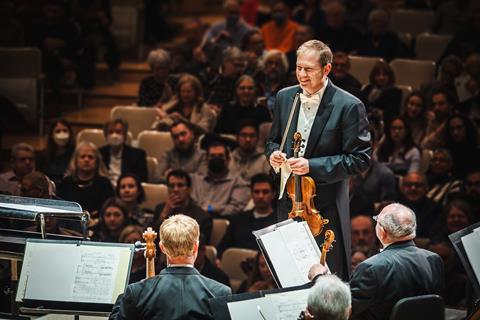Toronto Symphony Orchestra (TSO) concertmaster Jonathan Crow speaks about the challenges and fascinating elements of performing Ligeti’s Violin Concerto, ahead of performances marking the composer’s centenary

Discover more Featured Stories like this in The Strad Playing Hub
When did you first come across the Ligeti Violin Concerto? Is this your first time performing it?
This is a piece that I first performed just after I graduated from McGill University. Denys Bouliane, who directed the McGill Contemporary Ensemble, asked me to perform the piece, as he had worked with Ligeti previously and had always wanted to programme it at the school. I said yes without knowing anything about the work, as the only parts available at the time were rentals! It was a bit of a shock when I received the score and realised what I was in for, but happily we had plenty of rehearsal time and everyone was able to learn the piece without the stress of professional rehearsal deadlines. I highly recommend six weeks of rehearsals when learning a new concerto! A few years later we actually recorded live the complete concerti of Ligeti, so this will be my third time performing it.
Do you have any advice to string players learning the work? What’s the trickiest section or technique for you in the piece, and how do you overcome it?
For me the first movement is the most difficult, as the entire movement is fiendishly difficult, and it never stops. Every individual moment is hard, but the major difficulty comes from the fact that the solo violin plays continuous fast-patterned 16th (𝅘𝅥𝅯) notes for the entire movement, and doesn’t have the normal concerto flexibility to take time here and there in order to regroup for specific technical issues- similar perhaps to the last movement of Barber concerto, but longer and with double stops added constantly just for fun!
Metronome work for me has been extremely important, as well as run-throughs in order to build up both the mental and physical stamina to make it through the entire movement without fatigue.
What’s the best part about performing this work?
My favourite part about playing this concerto is hearing how the individually complicated lines come together to create music which at times is actually quite simple, and always accessible to an audience. There is something about the music which is understandable despite being extremely modern, and the variety of sounds and textures are constantly intriguing to a listener.
Tell us about the instrument you’re using to perform the Ligeti Concerto.
I’m very lucky to be performing on a 1742 Guarneri ’del Gesù’ violin which is currently on loan to the TSO for my use. It’s a fantastic violin which has the depth, clarity and power to project over an orchestra, but maintains an incredible beauty and nuance of tone even in the softest dynamic range.
Jonathan Crow performs the Ligeti Violin Concerto with the TSO on 25, 28 and 29 October 2023. Find out more here.
Check out Jonathan’s interview on the the concerto ‘Ligeti with Spaghetti’ here:
Read: Toronto Symphony Orchestra appoints new string players and receives record-breaking gift
Read: Ligeti Centenary: how the composer influenced string quartet writing in the 20th century
Read more Featured Stories like this in The Strad Playing Hub
The number one source for playing and teaching books, guides, CDs, calendars and back issues of the magazine.
In The Best of Technique you’ll discover the top playing tips of the world’s leading string players and teachers. It’s packed full of exercises for students, plus examples from the standard repertoire to show you how to integrate the technique into your playing.
The Strad’s Masterclass series brings together the finest string players with some of the greatest string works ever written. Always one of our most popular sections, Masterclass has been an invaluable aid to aspiring soloists, chamber musicians and string teachers since the 1990s.
American collector David L. Fulton amassed one of the 20th century’s finest collections of stringed instruments. This year’s calendar pays tribute to some of these priceless treasures, including Yehudi Menuhin’s celebrated ‘Lord Wilton’ Guarneri, the Carlo Bergonzi once played by Fritz Kreisler, and four instruments by Antonio Stradivari.













































No comments yet